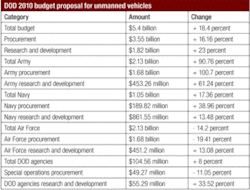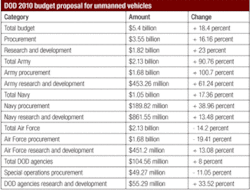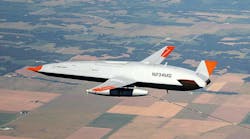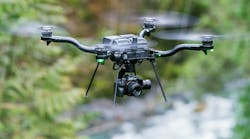By John Keller
U.S. military forces plan to spend nearly $5.4 billion next year on unmanned vehicle (UV) technology for air, ground, and maritime applications, according to identifiable unmanned vehicle line items in the fiscal 2010 U.S. Department of Defense (DOD) budget, which was released in May and sent to Congress for consideration.
The $5.4 billion proposed for UV technology next year is an increase of 18.4 percent over 2009 military unmanned vehicle spending of $4.53 billion. The actual amount proposed for unmanned vehicle development and related technology could be substantially higher, were UV components of larger procurement and research programs to be added.
Proposed military unmanned vehicle spending next year is up substantially from 2008 UV spending of $3.9 billion. Over the past two years, Pentagon spending for unmanned vehicles has increased by 37.5 percent.
These numbers reflect only the line items in the proposed 2010 DOD budget that specifically refer to unmanned vehicle technology. Federal fiscal year 2010 begins next Oct. 1.
The Pentagon’s unmanned vehicles spending plan for next year consists of $3.55 billion for procurement, up 16.16 percent from 2009, and $1.82 billion for research, development, test, and evaluation (RDT&E)–up by 23 percent from 2009 levels.
The vast majority of proposed DOD unmanned vehicle spending involves unmanned aerial vehicles (UAVs), which the Pentagon often refers to as unmanned aerial systems (UASs). Relatively little of the DOD’s UV budget is for unmanned ground vehicles (UGVs) or unmanned undersea vehicles (UUVs).
Unmanned aerial vehicles represent the most mature unmanned vehicle enabling technologies, and Pentagon observers say they expect spending for unmanned ground and marine vehicles to begin increasing rapidly over the next several years as UGV and UUV technologies mature.
Air Force
The U.S. Air Force proposes to spend $2.13 billion on unmanned vehicle technology next year: $1.68 billion for procurement, and $451.2 million for research and development.
In the procurement budget, the Air Force plans to buy five Northrop-Grumman RQ-4 Global Hawk high-altitude, long-endurance UAVs for $608.46 million, and will put an additional $113.05 million into Global Hawk advanced procurement toward future buys of Global Hawk UAVs and related equipment. The Air Force allocated money for five Global Hawks a year in 2008 and 2009.
Global Hawk is one of the largest UAVs flying, and is roughly the size of an F-16 jet fighter, but with a much wider wingspan. This aircraft is for long-duration, high-altitude reconnaissance missions using a variety of advanced radar and electro-optical sensor UAV payloads to see through clouds, darkness, and dust. In many ways this aircraft is an unmanned version of the U-2 and SR-71 reconnaissance aircraft.
Air Force leaders also are taking another step in building and deploying armed UAVs next year. The service is planning to spend $489.47 million to buy 24 General Atomics MQ-9 Reaper unmanned aircraft, essentially armed versions of the MQ-1 Predator unarmed surveillance UAV.
The MQ-9, however, is a larger and faster UAV Predator. It has six stores pylons for bombs, missiles, or external fuel tanks. An MQ-9 with two external fuel tanks and a thousand pounds of munitions can stay aloft for nearly two days. The Reaper can deliver the GBU-12 Paveway II laser-guided bomb, the AGM-114 Hellfire II air-to-ground missiles, and the GBU-38 Joint Direct Attack Munition. In the future, the Reaper may carry the AIM-9 Stinger air-to-air missile.
The Air Force does not plan to buy any Predator UAVs in 2010, after having allocated money for 4 and 38 Predators in 2008 and 2009, respectively.
Meanwhile, the Air Force next year plans to spend $134.86 million on modifications to Global Hawk, $188.9 million for modifications to Predator, and $148.04 million on modifications to Reaper.
In UAV research and development next year, the Air Force plans to spend $40.65 million on advanced Reaper development–a figure which is down from $46.4 million in 2009 and $55.86 million in 2008. The Air Force next year also plans to tuck away $19.5 million for research into advanced Predator technology, which is down sharply from $36.9 million in 2009.
For long-endurance UAV research and development, the Air Force plans to spend $317.3 million for Global Hawk development next year, and will begin the Endurance Unmanned Aerial Vehicles (EUAV) program with a research budget of $73.7 million. No Pentagon money was spent on EUAV research in 2008 or 2009.
In 2009, the Pentagon spent $5 million looking into hybrid electric renewable propulsion and power systems technology for high-endurance UAVs, yet no money is budgeted for this program in 2010.
Army
Following closely behind the Air Force in UAV spending levels is the U.S. Army, which plans to spend $2.13 billion on unmanned vehicle technology next year. Of that figure, $1.67 billion is for procurement, and $453.3 million is for research and development.
In the procurement budget, the Army plans to spend $651.36 million to buy 36 Predator UAVs, which is the service’s largest MQ-1 buy in several years. The Army allocated money for 24 Predators in 2008 and 12 Predators in 2009. The Army next year also plans to spend $87.4 million on Predator unmanned aerial system payloads.
In addition next year, the Army plans to spend $609.4 million for modifications to the AAI Corp. RQ-7 Shadow medium-sized UAV system, which launches on the battlefield from a rail system, and is recovered with an arresting system similar to aircraft carriers. Each Shadow system has four UAVs, two ground stations, one launch trailer, and support vehicles for equipment and personnel.
The Shadow UAV can fly for as long as six hours between refuelings, and gathers intelligence information on the local area with either an electro-optical sensor payload, or an RF-based signals intelligence payload.
The Army also plans to spend $79.65 million to buy 704 small manpack RQ-11 Raven UAVs from AeroVironment. This UAV is a remote-controlled miniature unmanned aerial vehicle that soldiers launch by hand literally by throwing it like a model airplane. It has an electric motor and can fly for as far as 6.2 miles at altitudes as high as 1,000 feet at speeds of 28 to 60 miles per hour. This UAV enables soldiers in the field to “see over the next hill.”
Also in the Army’s 2010 unmanned vehicles procurement budget is $14.8 million to weaponize the Predator UAV, and $235 million to buy 1,000 common remotely operated weapons stations, otherwise known as CROWS. For 2010, the Army has decided not to allocate procurement money for the Tactical Unmanned Aerial System (TUAS), the Small Unmanned Aerial System (SUAS), or to weaponize other unmanned aerial systems.
In unmanned vehicle research and development next year, the Army plans to spend $125.6 million for unmanned ground vehicle technology for the Future Combat Systems (FCS) program, as well as $68.7 million for FCS reconnaissance UAV technology. Also for the FCS program, the Army plans to spend $26.9 million to develop unattended ground sensors. Also in the Army’s research budget is $232.02 million for tactical unmanned aerial vehicle development.
The Army’s FCS program is developing small unmanned ground vehicles, which will be based on the iRobot Small Unmanned Ground Vehicle, also called the SUGV, which weighs 30 pounds. The iRobot SUGV is to be a cornerstone of the Army FCS program’s unmanned ground vehicle initiative.
The Lockheed Martin multifunction utility logistics equipment (MULE) UGV will fulfill the large UGV requirement of the FCS program. The MULE, which is the size of a large truck, has three variants–a transport variant that can haul cargo or people, a counter-mine variant designed to clear and mark lanes through mine fields, and an armed variant should the Army decide on that requirement in the future.
Navy and Marine Corps
The U.S. Navy and Marine Corps propose to spend $1.05 billion on unmanned vehicle technology next year. Of that figure, $189.8 million is for procurement, and $861.5 million is for research and development.
In the procurement budget, the Navy and Marine Corps plan to spend $56.8 million to buy 11 RQ-7 Shadow UAV systems, and $55.4 million to buy 517 small manpack RQ-11 Raven UAVs.
The Navy and Marine Corps procurement budget also has $77.6 million to buy five MQ-8 Fire Scout UAV systems from Northrop Grumman Corp, which are unmanned helicopters for reconnaissance and targeting that will replace the Navy’s RQ-2 Pioneer UAVs. The Fire Scout can carry 200 pounds of payload for eight hours between refuelings at speeds of 125 miles per hour at altitudes as high as 20,000 feet.
The MQ-8B has stub wings for aerodynamics and to carry weapons such as Hellfire missiles, Viper Strike laser-guided glide weapons, and a laser-guided 70 millimeter folding-fin rocket system. The Fire Scout also has a day/night sensor with laser target designator, and is able to carry a multispectral sensor, signals intelligence module, and the tactical common data link.
For next year, the Navy and Marine Corps have decided not to allocate money for the Marine Corps Tactical Unmanned Aerial System research program.
Special Forces and defense agencies
Non-service-related DOD agencies propose to spend $104.56 million on unmanned vehicle technology next year. Of that figure, $49.27 million is for procurement, and $55.29 million is for research and development.
In the procurement budget, U.S. Special Operations Command plans to allocate $12.28 million to support Predator UAV operations, $12.67 million to support Reaper UAV operations, and $24.2 million to support the Small Tactical Unmanned Aerial System (STUAS) Level-0 program.
The Office of the Secretary of Defense research budget contains $55.3 million for the Department of Defense Unmanned Aircraft System Common Development program.




